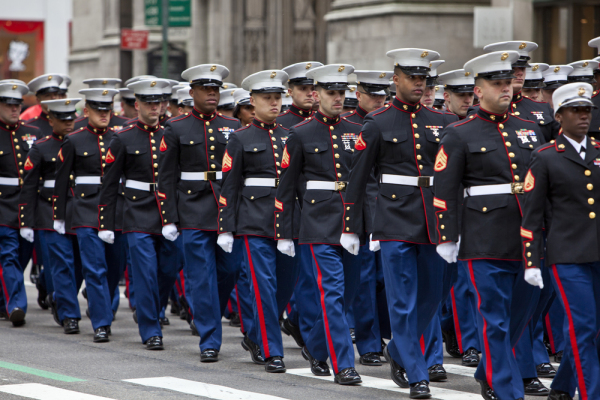
Founded in Tun Tavern (Yes, a bar) on November 10, 1775, the United States Marine Corps (USMC) has a long and storied history. In establishing the USMC, the Second Continental Congress sought to establish a force to conduct landing operations alongside the naval fleet. Since then, the USMC is steeped in a long tradition, has conducted over three hundred landings on to foreign shores, and has been a part of some of the most significant events in military history.
The USMC is symbolized by their eagle, globe, and anchor emblem (EGA); the eagle represents the United States of America and freedom, the globe represents their ability to serve and fight globally, and the anchor represents the Corps ability to conduct amphibious operations. Marines get the nickname “leathernecks” from the leather neckpiece once worn with their early uniforms. The Marine Corps motto is “Semper Fidelis,” always faithful.
In 1776, the USMC successfully carried out their first amphibious action, attacking islands in the Bahamas, seizing British munitions and supplies. The Marine Corps continued to fight and serve during the American Revolution, but were disbanded at the end of the conflict in 1783, only to be permanently reestablished in 1798. The Marines would go on to protect American interests globally during the 19th century, engaging pirates along the shores of Tripoli and protecting Washington during the War of 1812. The Marines would also seize key ports in the region during the Mexican-American War, and fight in some land combat but mostly assist the Navy in blockades and coastal fights during the American Civil War.
The USMC played a critical role during the Spanish-American War by attacking and seizing key terrain in the Caribbean and Southeast Asia. During the remainder of the 19th century and into the 20th century, the Corps would go on to help America establish many of the global outposts and territories it still retains today. Like many American units during WWI, the USMC instilled fear into the German forces and contributed immensely to their defeat in 1918. Critical battles like Belleau Wood lead to key strategic defeats, which were only made possible by the shear tenacity and bravery of the Marines who fought and held the highly contested ground on the western front.
With the surprise attack on Pearl Harbor forcing America formally into WWII at the end of 1941, the Marine Corps would again fight for not only American interests, but for the freedom of the world. Although America would suffer defeats early on, the Marine Corps would strike an early and critical victory against the Japanese in 1942 with the successful capture of Guadalcanal in the Solomon Islands. With this landing and victory, the USMC would begin the arduous task of reclaiming territory in the Pacific, island by island, to defeat the Japanese empire. The blood of countless Marines being spilt in the Pacific Theatre and the European Theatre helped to bring a decisive end to WWII.
Another moment in history which defined the USMC was their valiant retrograde operation out of the Chosin Reservoir, deep inside North Korean territory during the Korean War. Outnumbered, outgunned, and well beyond the main friendly lines, the Marines maintained their fighting capability and managed to fight their way out and rejoin friendly forces. This same type of defying-the-odds would also be exhibited in countless battles during the Vietnam War. During the Siege of Khe Sanh in 1968, the Marine firebase was pummeled daily by the North Vietnamese Army (NVA) for 3 months. However, the Marines not only held out, but they forced the NVA to withdraw from the area.
During the remainder of the Cold War, the USMC would take part in small operations globally, culminating in their participation in Desert Storm/Shield, where they fought alongside the large coalition to free Kuwait. The next chapters of the Corps were also tied to the Middle East, as America would call upon them to take the fight to its enemies in Afghanistan and Iraq. Battles like Fallujah resonate in Marine Corps lore, as those Marines fought an entrenched and determined enemy in close urban combat, again, winning a hard-fought victory.
From this legacy, the USMC continues to live up to the virtues which prior Marines have fought and died to uphold. With the current lull in major combat operations for America, the USMC stays well-trained and poised to close with and kill the enemy. America will always have the ability to call on its Marine Corps to be the first in and instill fear into the enemy.
